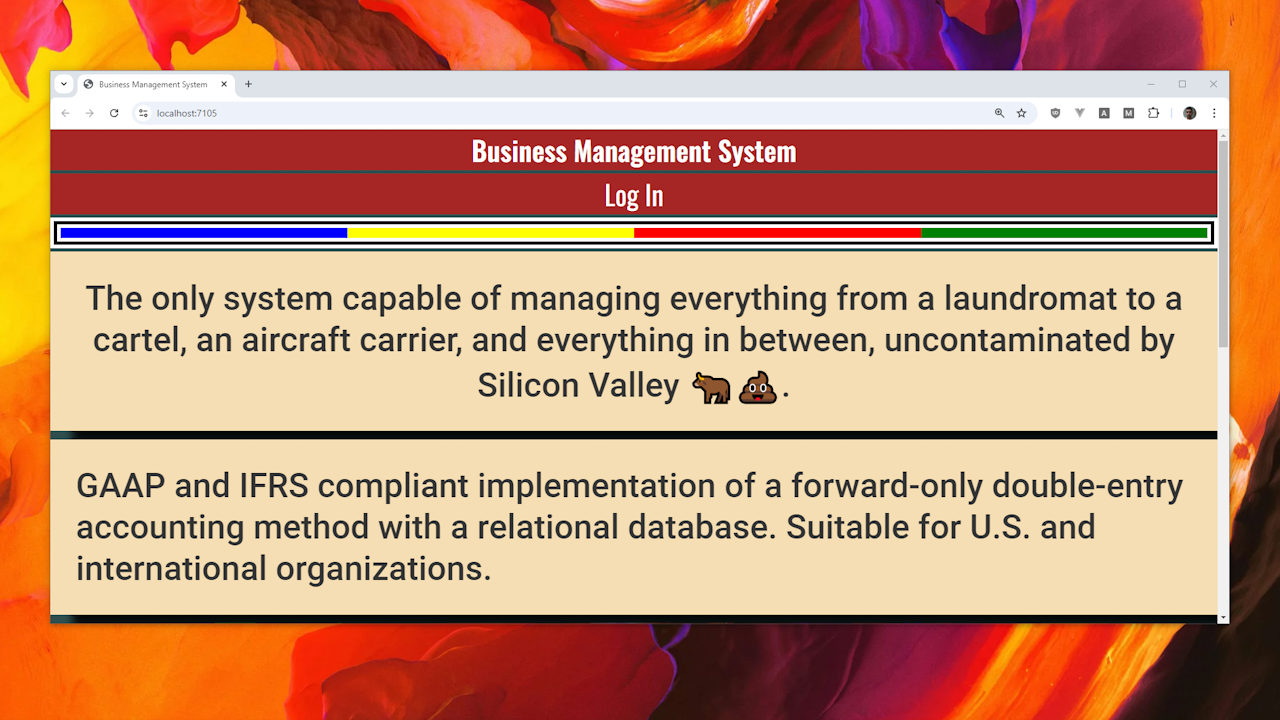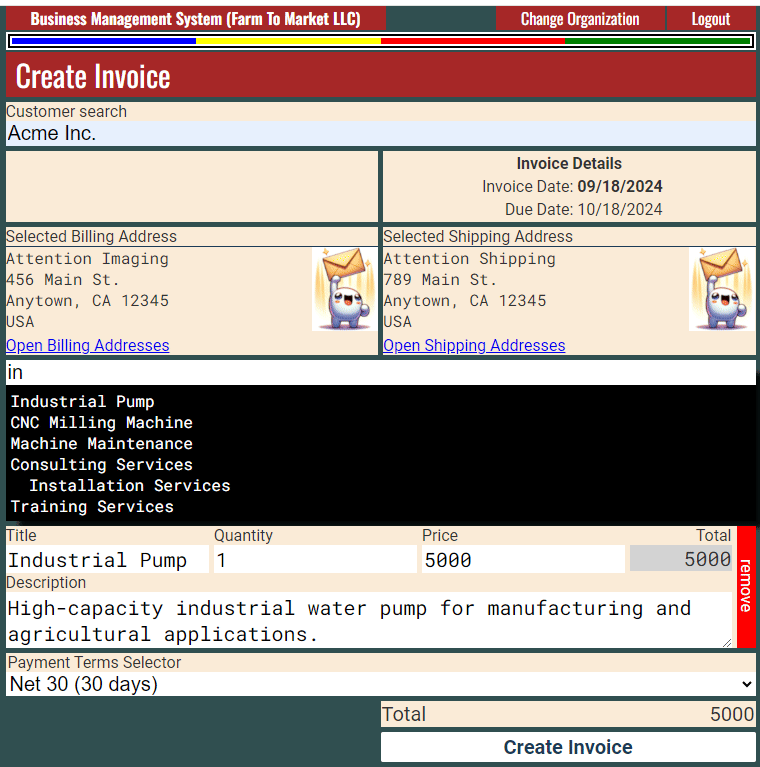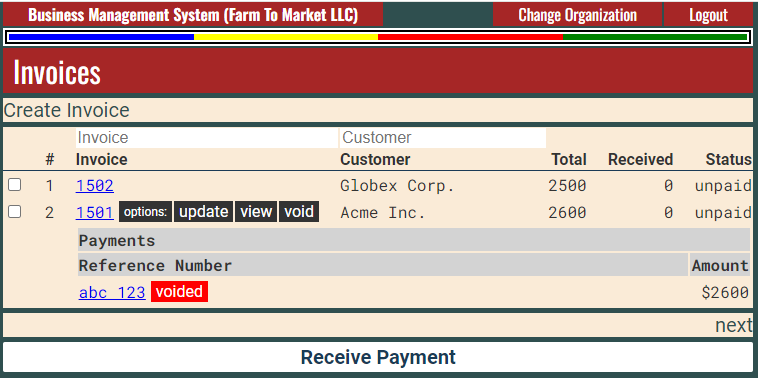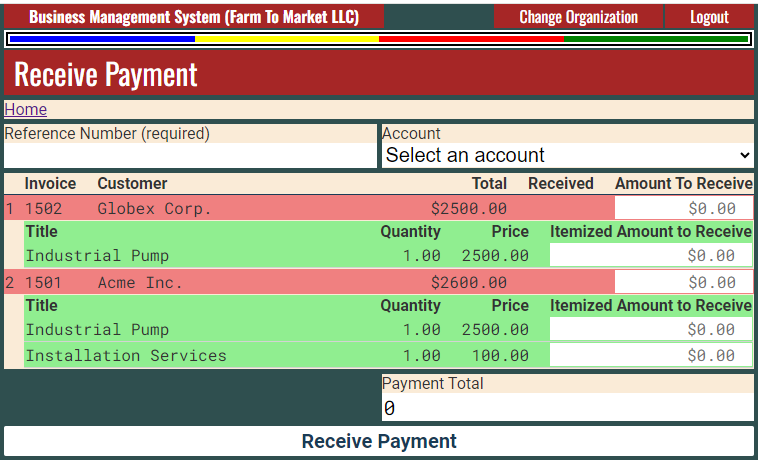| Account Type | Debit | Credit |
|---|---|---|
| Assets | Increase | Decrease |
| Liabilities | Decrease | Increase |
| Equity/Capital | Decrease | Increase |
| Revenue/Income | Decrease | Increase |
| Expenses | Increase | Decrease |
GAAP and IFRS compliant implementation of a forward-only double-entry accounting method with a relational database. Suitable for U.S. and international organizations.
The only system capable of managing everything from a single laundromat to a cartel, multiple aircraft carriers, and everything in between, uncontaminated by Silicon Valley 🐂💩.
Due to its wide scope, the system is designed to be incomplete, allowing organizations to finalize the implementation.
- Using: C# • ASP.NET MVC • Vue.js • PostgreSQL
This solution contains example integrations of feature-specific junction tables which group the journal entries into a transaction for specific user action or feature.
A feature should be integrated with the journal if it affects one of the following account types: revenue, expense, liabilities, assets, or equity.
Since every feature that impacts the journal requires a minimum of two entries, a TransactionGuid column is used to group these entries together.
To implement a new feature affecting the journal, create a table to group the transaction. Prefix the table with Journal..., then append the names of the tables referenced by the foreign keys that appear immediately after the JournalId foreign key and before the Reversed... column (excluding the "Id" suffix from each). For example, JournalInvoiceInvoiceLine is named as such because the foreign keys after the JournalId but before Reversed... columns are InvoiceId and InvoiceLineId. Include a Reversed... column to reference the entries being reversed, and a TransactionGuid for grouping entries. This structure supports a reversal-and-amendment strategy in a forward-only journal, where entries cannot be modified once recorded. For example, if the revenue recognition for invoice line-items needs to be adjusted after initial creation, the original entries are reversed, and new ones are added.
CREATE TABLE "JournalInvoiceInvoiceLine"
(
"JournalInvoiceInvoiceLineID" SERIAL PRIMARY KEY NOT NULL,
"JournalId" INT NOT NULL,
"InvoiceId" INT NOT NULL,
"InvoiceLineId" INT NOT NULL,
"ReversedJournalInvoiceInvoiceLineId" INT NULL,
"TransactionGuid" UUID NOT NULL,
"Created" TIMESTAMPTZ NOT NULL DEFAULT (CURRENT_TIMESTAMP AT TIME ZONE 'UTC'),
"CreatedById" INT NOT NULL,
"OrganizationId" INT NOT NULL,
FOREIGN KEY ("JournalId") REFERENCES "Journal"("JournalID"),
FOREIGN KEY ("InvoiceId") REFERENCES "Invoice"("InvoiceID"),
FOREIGN KEY ("InvoiceLineId") REFERENCES "InvoiceLine"("InvoiceLineID"),
FOREIGN KEY ("ReversedJournalInvoiceInvoiceLineId") REFERENCES "JournalInvoiceInvoiceLine"("JournalInvoiceInvoiceLineID"),
FOREIGN KEY ("CreatedById") REFERENCES "User"("UserID"),
FOREIGN KEY ("OrganizationId") REFERENCES "Organization"("OrganizationID")
);This naming strategy makes it easy for developers to understand the relationship between features and the journal.
The JournalInvoiceInvoiceLine is used to record entries during creation of the invoice, the modification of the line-items, and the removal of the line-items from the invoice. However, if you require these concepts to be separated even further, you could adopt a different naming strategy, for example, JournalInvoiceInvoiceLineCreated, JournalInvoiceInvoiceLineUpdated, JournalInvoiceInvoiceLineRemoved.
For example, it may be useful to know how much revenue is lost due to line-items being removed from the invoice.
CREATE TABLE "Account"
(
"AccountID" SERIAL PRIMARY KEY NOT NULL,
"Name" VARCHAR(200) NOT NULL,
"Type" VARCHAR(50) NOT NULL CHECK ("Type" IN ('assets', 'liabilities', 'equity', 'revenue', 'expense')),
-- ...
"Created" TIMESTAMPTZ NOT NULL DEFAULT (CURRENT_TIMESTAMP AT TIME ZONE 'UTC'),
"ParentAccountId" INT NULL,
"CreatedById" INT NOT NULL,
"OrganizationId" INT NOT NULL,
FOREIGN KEY ("ParentAccountId") REFERENCES "Account"("AccountID"),
FOREIGN KEY ("CreatedById") REFERENCES "User"("UserID"),
FOREIGN KEY ("OrganizationId") REFERENCES "Organization"("OrganizationID"),
UNIQUE ("Name", "OrganizationId")
);The ParentAccountId allows for hierarchical relationships which allow for better reporting and analysis. However, ensuring that the ParentAccountId is of the same Type as the AccountID is enforced at application level.
CREATE TABLE "Journal"
(
"JournalID" SERIAL PRIMARY KEY NOT NULL,
"AccountId" INT NOT NULL,
"Credit" DECIMAL(20, 4) NULL,
"Debit" DECIMAL(20, 4) NULL,
"CurrencyCode" VARCHAR(3) NULL,
"ExchangeRate" DECIMAL(12, 5) NULL,
"Memo" TEXT NULL,
"Created" TIMESTAMPTZ NOT NULL DEFAULT (CURRENT_TIMESTAMP AT TIME ZONE 'UTC'),
"CreatedById" INT NOT NULL,
"OrganizationId" INT NOT NULL,
FOREIGN KEY ("AccountId") REFERENCES "Account"("AccountID"),
FOREIGN KEY ("CreatedById") REFERENCES "User"("UserID"),
FOREIGN KEY ("OrganizationId") REFERENCES "Organization"("OrganizationID")
);Journal entries are made in transactions of at least two entries where the sum of credits equals debits.
Double entry is misleading because some people assume the entries of a transactions are made in pairs, or have an even number of entries.
A typical chart-of-accounts might look like...
| AccountID | Name | Type | ParentAccountId |
|---|---|---|---|
| 1 | accounts-receivable | assets | NULL |
| 2 | revenue | revenue | NULL |
| 3 | revenue-service | revenue | 2 |
| 4 | revenue-product | revenue | 2 |
| 5 | cash | assets | NULL |
| 6 | chase-9988 | assets | NULL |
| 7 | chase-9988-debit-card-2323 | assets | 6 |
| 8 | expense | expense | NULL |
| 9 | expense-diesel | expense | 8 |
| 10 | expense-meals | expense | 8 |
| 11 | expense-maintenance | expense | 8 |
| 12 | discover-5555 | liabilities | NULL |
| 13 | inventory | assets | NULL |
| 14 | sales-tax-payable | liabilities | NULL |
Keep an eye on number 14.
Consider a transaction where an invoice is created with one line-item which requires sales tax to be collected...
| JournalID | AccountId | Credit | Debit |
|---|---|---|---|
| 1 | 1 (ar) | 0.00 | 1100.00 |
| 2 | 2 (revenue) | 1000.00 | 0.00 |
| 3 | 14 (liabilities) | 100.00 | 0.00 |
The above table shows a valid transaction made up of three entries where debits equal credits.
Examine the TransactionGuid column in the table below from the result of SELECT * FROM "JournalInvoiceInvoiceLine"; to identify transaction boundary.
| ID | JournalId | InvoiceId | InvoiceLineId | ReversedId | TransactionGuid |
|---|---|---|---|---|---|
| 1 | 2 | 1 | 1 | NULL | e0b84e1c-e62d-60f2-0a96-61f895c14fcf |
| 2 | 1 | 1 | 1 | NULL | e0b84e1c-e62d-60f2-0a96-61f895c14fcf |
| 3 | 4 | 1 | 2 | NULL | e0b84e1c-e62d-60f2-0a96-61f895c14fcf |
| 4 | 3 | 1 | 2 | NULL | e0b84e1c-e62d-60f2-0a96-61f895c14fcf |
| 5 | 5 | 1 | 1 | 1 | 91977936-5d6a-401b-7ea6-9092eee92918 |
| 6 | 6 | 1 | 1 | NULL | 91977936-5d6a-401b-7ea6-9092eee92918 |
| 7 | 7 | 1 | 1 | 2 | 91977936-5d6a-401b-7ea6-9092eee92918 |
| 8 | 8 | 1 | 1 | NULL | 91977936-5d6a-401b-7ea6-9092eee92918 |
| 9 | 9 | 1 | 2 | 3 | 91977936-5d6a-401b-7ea6-9092eee92918 |
| 10 | 10 | 1 | 2 | NULL | 91977936-5d6a-401b-7ea6-9092eee92918 |
| 11 | 11 | 1 | 2 | 4 | 91977936-5d6a-401b-7ea6-9092eee92918 |
| 12 | 12 | 1 | 2 | NULL | 91977936-5d6a-401b-7ea6-9092eee92918 |
| 13 | 13 | 1 | 1 | 6 | 227fa74a-3166-01b6-61db-0f6a6af4a52e |
| 14 | 14 | 1 | 1 | 8 | 227fa74a-3166-01b6-61db-0f6a6af4a52e |
Note the reversing entries and the three separate transactions.
- Rows 1-4 invoice with two line-items is created.
- Rows 5-12 both line-items updated.
- Rows 13-14 one line-item is removed.
To prevent confusion regarding how to determine if a line-item was removed from an invoice, and without adding additional flags or columns to indicate line-item removal, the line-items whose transactions end with a reversal are considered removed from the invoice.
- Payments are received against invoice line-items.
- Payments can be partial.
- The relationship between payment and invoice is many-to-many.
The JournalInvoiceInvoiceLinePayment links the journal entries with the payment.
CREATE TABLE "JournalInvoiceInvoiceLinePayment"
(
"JournalInvoiceInvoiceLinePaymentID" SERIAL PRIMARY KEY NOT NULL,
"JournalId" INT NOT NULL,
"InvoiceInvoiceLinePaymentId" INT NOT NULL,
"ReversedJournalInvoiceInvoiceLinePaymentId" INT NULL,
"TransactionGuid" UUID NOT NULL,
"Created" TIMESTAMPTZ NOT NULL DEFAULT (CURRENT_TIMESTAMP AT TIME ZONE 'UTC'),
"CreatedById" INT NOT NULL,
"OrganizationId" INT NOT NULL,
FOREIGN KEY ("JournalId") REFERENCES "Journal" ("JournalID"),
FOREIGN KEY ("InvoiceInvoiceLinePaymentId") REFERENCES "InvoiceInvoiceLinePayment"("InvoiceInvoiceLinePaymentID"),
FOREIGN KEY ("ReversedJournalInvoiceInvoiceLinePaymentId") REFERENCES "JournalInvoiceInvoiceLinePayment" ("JournalInvoiceInvoiceLinePaymentID"),
FOREIGN KEY ("CreatedById") REFERENCES "User"("UserID"),
FOREIGN KEY ("OrganizationId") REFERENCES "Organization" ("OrganizationID")
);An incoming check is usually entered into the system before it is deposited. Ideally, the check should be entered into a check-in-transit or similar asset account and later synchronized when it appears on the statement.
The pattern repeats in the JournalReconciliationTransaction table. A bank or credit card statement contains rows of transactions. Credit card statements will have expense transactions while bank statements will have both expense and revenue transactions.
Each transaction in the statement should be uniquely identifiable, but often the exported CSV does not contain a column to uniquely identify the row.
CREATE TABLE "JournalReconciliationTransaction"
(
"JournalReconciliationTransactionID" SERIAL PRIMARY KEY NOT NULL,
"JournalId" INT NOT NULL,
"ReconciliationTransactionId" INT NOT NULL,
"ReversedJournalReconciliationTransactionId" INT NULL,
"TransactionGuid" UUID NOT NULL,
"Created" TIMESTAMPTZ NOT NULL DEFAULT (CURRENT_TIMESTAMP AT TIME ZONE 'UTC'),
"CreatedById" INT NOT NULL,
"OrganizationId" INT NOT NULL,
FOREIGN KEY ("JournalId") REFERENCES "Journal" ("JournalID"),
FOREIGN KEY ("ReconciliationTransactionId") REFERENCES "ReconciliationTransaction"("ReconciliationTransactionID"),
FOREIGN KEY ("ReversedJournalReconciliationTransactionId") REFERENCES "JournalReconciliationTransaction" ("JournalReconciliationTransactionID"),
FOREIGN KEY ("CreatedById") REFERENCES "User"("UserID"),
FOREIGN KEY ("OrganizationId") REFERENCES "Organization" ("OrganizationID")
);- Have
dotnetinstalled. - Have
psqlinstalled.- Have
CREATE EXTENSION IF NOT EXISTS postgis;installed. - Have
CREATE EXTENSION IF NOT EXISTS pgcrypto;installed.
- Have
- Update connection strings in
appsettings.json. - Set
database-reset.jsontotrueand run. This does two things...- Uses the main database context to create the application database.
- Runs
create-db...script to create tables, columns, relationships, indexes, etc. I will later separate sample data to be optional.
- Use
test@example.compwtestto login and choose "Farm To Market LLC", it already has sample chart of accounts. - Create invoice.
- Receive payment.
3-24 months.





